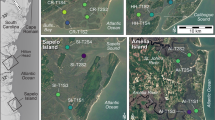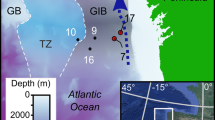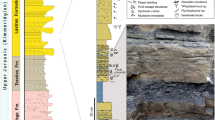Abstract
MANY attempts to reconstruct the pattern of apparent sea-level rise that took place during the Holocene have used salt-marsh deposits as indicators of former sea level1,2. Contemporary mature salt marshes occupy a vertical range covering the upper half of the tidal range, from mean sea level to higher high water3,4, and geologists have arbitrarily equated ancient marsh deposits with various fixed elevations within this range. This method, disregarding any other source of inaccuracy, can introduce an error of 1–5 m depending on the tidal range. Apparent sea level movements during the late Holocene (2,000–3,000 yr BP) have been of the order of 1–2 m; hence such a method introduces errors larger than the movements being measured. Even less adequate sea-level estimates are derived from other commonly used indicators such as raised beaches, oyster beds, and submerged or emerged terraces and deltas. We describe here how marsh foraminifera can be used to delimit small-scale vertical zones along modern marsh surfaces generally corresponding to the floral zones in vertical range. This relationship was first established in the marshes of southern California5, and has recently been shown to be valid in other areas6.
This is a preview of subscription content, access via your institution
Access options
Subscribe to this journal
Receive 51 print issues and online access
$199.00 per year
only $3.90 per issue
Buy this article
- Purchase on Springer Link
- Instant access to full article PDF
Prices may be subject to local taxes which are calculated during checkout
Similar content being viewed by others
References
Redfield, A. C. Science 157, 687–692 (1967).
Grant, D. R. Can. J. Earth Sci. 7, 676–689 (1970).
Chapman, V. J. Salt Marshes and Salt Deserts of the World (Leonard Hill, London, 1960).
Chapman, V. J. Coastal vegetation 2nd edn (Pergamon, Toronto, 1976).
Scott, D. B. 1st Int. Symp. Benthonic Foraminifera of Continental Margins Spec. Publ. 1, 153–170 Halifax, Nova Scotia (1976).
Scott, D. B. thesis, Dalhousie Univ. (1977).
Phleger, F. B. Limnol. Oceanogr. 10, R169–R184 (1965); Bol. Soc. Geol. Mexicana 28, 1–44 (1966); Ann. Inst. Biol. Univ. Nat. Auton. Mexico, 38, Ser. Ciencias del Mar y Limn. 1, 11–38 (1967); Limnol. Oceanogr. 4, 522–534 (1970).
Phleger, F. B. & Bradshaw, J. S. Science 154, 1551–1553 (1966).
Ellison, R. L. & Nichols, M. M. 1st Int. Symp. Benthonic Foraminifera of Continental Margins. Spec. Publ. 1, 131–151 Halifax, Nova Scotia (1976).
Albani, A. D. & Johnson, K. R. J. geol. Soc. Austr. 22, 435–446 (1975).
Kaye, C. A. & Barghoorn, E. S. Geol. Soc. Am. Bull. 75, 63–80 (1964).
Murray, J. W. J. Foram. Res. 1, 153–161 (1971).
Scott, D. B. J. Foram. Res. 6, 312–321 (1976).
Author information
Authors and Affiliations
Rights and permissions
About this article
Cite this article
SCOTT, D., MEDIOLI, F. Vertical zonations of marsh foraminifera as accurate indicators of former sea-levels. Nature 272, 528–531 (1978). https://doi.org/10.1038/272528a0
Received:
Accepted:
Issue Date:
DOI: https://doi.org/10.1038/272528a0
This article is cited by
-
Identifying and Constraining Marsh-Type Transitions in Response to Increasing Erosion over the Past Century
Estuaries and Coasts (2024)
-
Correlation of foraminifera content and granulometric properties of sediment in different transitional environments along a karstic coast, eastern Adriatic, Croatia
Journal of Soils and Sediments (2023)
-
Common Era sea-level budgets along the U.S. Atlantic coast
Nature Communications (2021)
-
Benthic foraminifera as bioindicators of environmental quality of Dammam Al-Jubail area, Arabian Gulf, Saudi Arabia
Arabian Journal of Geosciences (2020)
-
Responses of benthic foraminifera to changes of temperature and salinity: Results from a laboratory culture experiment
Science China Earth Sciences (2019)
Comments
By submitting a comment you agree to abide by our Terms and Community Guidelines. If you find something abusive or that does not comply with our terms or guidelines please flag it as inappropriate.



